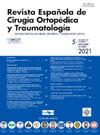[Artículo traducido] Enclavado de fracturas intertrocantéricas en población geriátrica: ¿lo sabemos todo?
Q3 Medicine
Revista Espanola de Cirugia Ortopedica y Traumatologia
Pub Date : 2025-03-01
DOI:10.1016/j.recot.2025.01.003
引用次数: 0
Abstract
Introduction and objectives
Pertrochanteric fractures constitute an important part of the daily activity of the orthopedic surgeon. The aim of this study was to carry out an analysis of pre-, intra- and post-operative radiographic parameters and to analyze the results of stable and unstable intertrochanteric fractures treated with short nails with dynamic distal locking.
Materials and methods
Retrospective study in our center, between the years 2017-2021 of patients over 65 years of age with pertrochanteric fracture. We included 272 patients treated with Gamma3 Nail (Stryker®) with dynamic distal locking. As variables, we recorded: age, medical comorbidities, fracture pattern according to AO/OTA, osteopenia according to Singh's classification, pre-operative (such as diaphyseal extension), intra-operative (such as tip-to-the-apex or medial cortical support) and post-operative radiographic parameters (such as time to consolidation or loss of reduction), pre- and post-operative Barthel, quality of life and complications and reinterventions, such as non-union or cut-out.
Results
The mean age was 83.28 years (65-102). Two hundred four cases were women (75%). The average follow-up was 18.2 months (12-24). The distribution according to AO/OTA classification was 85.7% 31.A1; 12.5% 31.A2; 1.9% 31.A3. Radiographic consolidation was obtained in 97.4% of cases. Tip to apex distance was less than 25 mm in 95.6% of cases. Medial cortical support was positive or neutral in 88.6% of cases. Sixty cases (22.1%) of screw back-out were recorded. Eight reinterventions (2.9%) were performed, corresponding to three cut-outs (1.1%), three non-unions (1.1%), one avascular necrosis (0.4%) and one secondary hip osteoarthritis (0.4%).
Conclusions
Short nail with dynamic distal locking offers good clinical, radiological and functional results in all types of AO/OTA patterns, without increasing the complication rate, as long as there is an appropriate tip-to-the-apex distance and good medial cortical support.
求助全文
约1分钟内获得全文
求助全文
来源期刊

Revista Espanola de Cirugia Ortopedica y Traumatologia
Medicine-Surgery
CiteScore
1.10
自引率
0.00%
发文量
156
审稿时长
51 weeks
期刊介绍:
Es una magnífica revista para acceder a los mejores artículos de investigación en la especialidad y los casos clínicos de mayor interés. Además, es la Publicación Oficial de la Sociedad, y está incluida en prestigiosos índices de referencia en medicina.
 求助内容:
求助内容: 应助结果提醒方式:
应助结果提醒方式:


